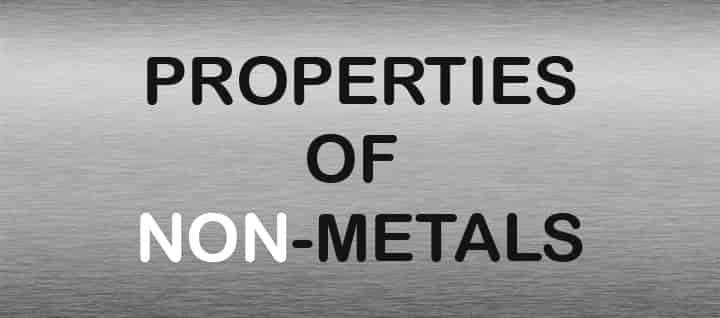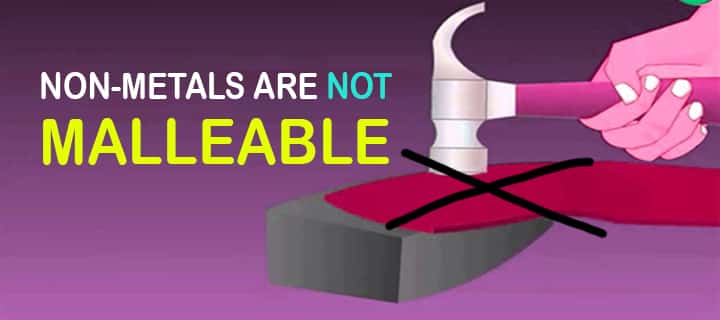In this article, we will learn the properties of non-metals along with various examples, etc. Let’s explore!
What are the Properties of Non-Metals
Let’s try to understand the properties of non-metals. When we look around, the whole world is made of matter. All of it is in either in form of elements, compounds, and mixtures. When elements come to our mind we think of metals and non-metals. We use metals extensively, but our life breath depends on non-metals.

- Without oxygen, we cannot survive for even a day.
- Without carbon, there will be no photosynthesis and hence no life.
- Not just biologically but in the material aspect, non-metals and their compounds are used by us extensively.
- Common salt, baking powder, etc are daily life necessities.
Lastly in the engineering world, without steel every industry will cripple, that steel itself is an alloy of metals and non-metal.
Physical and Chemical Properties of Non-Metals
Let’s see the physical and chemical properties of non-metals. Physical properties of non-metals are based on the following,
- Malleability
- Ductility
- Sonorous
- Lustre
- Physical state
- Density
- Conductivity
The chemical properties of non-metals are based on the following,
- Reaction with Acids
- Reaction with Base
- Reaction with Water
- Reaction with Air
- Reactivity
Physical Properties of Non-metal
Malleability
It is the ability of a material to be beaten into thin sheets or rolled into thin sheets. Non-Metals are not malleable.

Ductility
It is able to be drawn into wire. Non-metals are not ductile.
Sonorous
Simply put it’s a property that makes a sound after hitting. Non-metals are not sonorous.
Lustre
The incident light gets reflected by the material and this is called luster. Non-metals are dull. They don’t have luster. The only exception being iodine which has luster.
Physical state
Non-Metals are generally in a solid or gaseous state at room temperature. The only exception is bromine. They are all generally soft except diamond, which is the hardest substance in the world.

Density
It is a ratio of mass to volume. Generally, all non-metals are lighter in nature.
Conductivity
Non-Metals have low conductivity. They are really bad conductors of heat as well as electricity. Hence, non-metals are used as insulators. Carbon coating is given in many equipment. The only exception being graphite.
As atoms are loosely packed in non-metals, this energy gets transferred very slowly, as one atom starts vibrating its results but it takes time to reach the next one. This way non-metal takes a lot of time to get heated due to the process of conduction. They have a comparatively low melting and boiling point. Except for diamond which has high melting and boiling point.
While their atomic structure is such that their valency is 1, 2, and 3. (4 in case of carbon) That means this material in their outer orbit is short of 1, 2, 3 valence electrons to complete their orbit and get in a stable state. So, it becomes easy to gain such electrons to form octet, and hence metals are electronegative in nature. It’s very hard to lose 5, 6, 7 electrons and they generally accept electrons. Non-metal’s electronegativity is what distinguishes them from metals.
Chemical properties of Non-Metals
Reaction with Acids
Non-Metals do not react with acids. The reason being they are acceptors of electrons, that they are electronegative in nature. They don’t give up their electron to form ions.
Reaction with Base
Generally, rare gases and nitrogen don’t react with bases. Most of the other non-metals react with bases or alkali hydroxides. As a result, corresponding salt is formed. Example – chlorine which is a non-metal reacting with sodium hydroxide which happens to be a strong base.
Cl2 + 2NaOH = NaCl + NaOCl + H2O
The above reaction shows multiple products are obtained. Sodium chloride, sodium hypochlorite, and water. Sodium chloride is salt obtained from this reaction. As we know non-metals are electronegative in nature, they are acceptors of electrons. While bases are donors, when these both react, bases donate their electrons which are accepted by non-metals to form a salt.
Reaction with Water
Generally, non-metals do not react to water. Just chlorine reacts with water to form an acidic solution.
Reaction with Air
Non-metals do not react with air. Just white phosphorus reacts with air vigorously. Due to this reason, it is stored in water.
Reactivity
In displacement reaction highly reactive non-metal always displaces less reactive non-metal in a chemical reaction. For example, in the Halogen group (Cl, Br, I, Fl) chlorine is more reactive than bromine and iodine. Thus, chlorine can displace Br and I to form solutions of bromides (NaBr) and (NaI).
(Cl, Br, I, Fl) chlorine is more reactive than bromine and iodine. Thus, chlorine can displace Br and I to form solutions of bromides (NaBr) and (NaI).
Metalloids
Metalloids are materials that tend to have metals and non-metals properties. The other name is a semi-metal. Example:
- Boron,
- Silicon,
- Germanium,
- Antimony,
- Arsenic.
This table makes it easy to memorize metals and non-metals differences.
Difference between Metals & Non-Metals Properties
The differences between metals and non-metals are as follows,
| Parameter | Metals | Non-metals |
| Appearance | Lustre | Not shiny |
| Hardness | Hard | Soft/Brittle |
| Malleable | Beaten into sheet | Cannot be beaten into a sheet |
| Ductile | Drawn in wire | Are not ductile |
| Heat conduction | Good conduction | Bad conduction |
| Electricity conduction | Good conduction Except for mercury which is a bad conductor | Bad conduction Except for graphite which is a good conductor |
| Sonorous | Yes | No |
| Physical state | Generally solid at room temperature, except mercury. | Generally solid and gaseous at room temperature. Except for bromine. |
| Melting and Boiling point | Both points are high except gallium and cesium | Both points are low except diamond and graphite |
| Periodic table position | At left and center. S and D block | Right side P block |
| Density | High | Low |
| Agents | Reducing agents | Oxidizing agents |
| Oxides | Basic | Acidic or neutral |
| Electron sharing | Electropositive – they give away electron | Electronegative- They take an electron |
Table for memorizing chemical reactions
| Metals | Non-metals |
| Reaction with acids Metals go through a chemical reaction to form metal salt and release hydrogen gas | Reaction with acids Non-metals do not react with acids. |
| Reaction with base Metals go through a chemical reaction to form metal salt and release hydrogen gas | Reaction with base Some non-metals react with bases to form a salt. In this case, though no hydrogen gas is created. |
| Reaction with oxygen, Metals form respective metal oxide in such reactions | Reaction with oxygen, Non-metals don’t react with oxygen. |
| Reaction with water They react to form hydroxide and hydrogen gas. | Reaction with water They don’t go through reaction. |
Reaction between Metals and Non-Metals
To understand this let’s take the example of sodium and chlorine. Sodium atomic number is 11 and it has 3 shells K, L, M. last shell has only one electron while chlorine’s atomic number is 17 which too has three shells. In its outer shell, it has 7 electrons. Every atom wants 8 electrons in its outer shell to form a complete octet. So, when sodium loses its 1 electron from the outer shell, it gains a positive charge. This is because it has 11 protons and 10 electrons with 2 shells. This net positive charge is known as cation Na+. While chlorine accepts that electron, it gains a negative charge because chlorine has 18 electrons and 17 protons. This net charge gain is called as anion Cl-. As sodium and chloride are oppositely charged, they tend to attract each other, such bonds are strongly held by the electrostatic force of attraction to an ionic compound which is sodium chloride in this case. Such compounds form by transfer of an electron from metal to non-metals are known as ionic compound or electrovalent compound. Example NaCl, LiCl.
Properties of an ionic compound
- Physically they are hard as they have strong force of attraction between them. They are brittle in nature.
- high boiling and melting points is always seen amongst them. This is due to fact lot of energy is needed to break the ionic bond.
- They are soluble in water and insoluble in solvents like kerosene and water.
- They don’t conduct electricity in their solid form but in aqueous solution. This is due to fact due to rigid their rigid structure flow of electrons is not constituted. This conduction of electricity is due to movement of charged particle. An aqueous solution of ionic compound in water contains ions which move to oppositely charged electrode when electricity is allowed to pass through this solution. In molten state, electrostatic force of attraction is overcome due to heat. Due to this ions move freely and conduct electricity.
Periodic Table for Properties of Non-Metals
As we all know horizontal rows are called periods and vertical columns are groups. In the periodic table left and middle side is occupied by metals while the top right corner and extreme right are occupied by non-metals.
Electronegativity goes on increasing when we move up and towards the right side of the table. Ionization energy also follows the same pattern. Atomic size goes on increasing as we move down and to right. These 3 properties are clearly noticed as me from left to right and from top to bottom.
- Ionisation energy
It goes on increasing as we move to rightwards in the period. It goes on decreasing in the group. At lower periods it rises more slowly compared to upper period.
- Electron affinity
It also goes on increasing as we move to the right across a period. Now non-metals majorly consist of
- Noble gases
- Halogens
- Chalcogen
Noble gases
They are extreme right of the periodic table. They are in group 18. Helium, neon, krypton is its example. They are chemically inert. Applications are:
- Argon is used in arc welding and electric bulb.
- Helium being light and inflammable is used in balloon and weather indicator.
- Neon is used in tubes to glow light.
- Krypton is used in airport landing lights.
Halogens
They are situated in group 17. Fluorine, chlorine, bromine, iodine, and astatine. These all have high electron affinity and ionization energy. Fluorine is obtained in form of fluorite. Other halogens are obtained by isolating them from salts in seawater. They are obtained by the oxidation process of halide ions to halogen in a molten state of salt, except fluorine which needs a special procedure.
Applications
- Chlorofluoro carbon is called as Freon and used as refrigerant and aerosol.
- Chlorine is used for making pesticides, insecticides, and PVC.
- Chlorine is also used as bleaching agent.
- Bromide is used in photo labs.
- Teflon, which is a non-stick polymer, made of carbon and fluorine is used as coating in utensils.
- HCFC and CFC are majorly used refrigerants.
- Fluorine is used in dental products to reduce tooth decay.
Chalcogen
These are elements in group 16. Oxygen, sulfur, selenium, tellurium, and polonium. Polonium is the least electronegative and most metallic of them all. Oxygen has two allotropes. Ozone and oxygen. Ozone is the gas that absorbs ultraviolet rays in the stratosphere while oxygen is the gas we inhale during respiration.
Sulfur
It is used mostly in making acids, vulcanization of rubber, and gun powder. It is also a strong reducing agent in the purification and extraction of metals from ore.
Group 15
Nitrogen, phosphorus, and arsenic are present in this group.
Nitrogen
It is a diatomic molecule and the most abundant one in the atmosphere.
Applications
- Used as inert gases in food packaging industry to remove oxygen from packets to make food long lasing in nature.
- Liquid nitrogen is used as coolant.
- Biggest use of nitrogen is to nitrogenous fertilizer.
- To produce ammonia compound which is used extensively in following applications-
- As a refrigerant in ice factory.
- Urea, ammonium sulphate fertiliser.
- Forming baking powder.
- Preparing explosives.
- Preparing artificial silk.
Phosphorus
This element also shows allotropy in form of white and red phosphorus. White phosphorus is more reactive.
Applications
- Production of matchsticks.
- Production of crackers.
- Production of explosives.
Group 14
It contains carbon, silicon, and germanium. Carbon is one of the most abundant of all elements. It also shows allotropy.
Carbon
Graphite and diamond are its allotropes. Both have different structures. In diamond, a single carbon atom always attaches itself to 4 others making it 3d structure. In graphite, each carbon atom is bonded to 3 other carbon atoms in the same plane giving a hexagonal array. This structure makes their property different than each other; diamond becomes the hardest substance of all while graphite becomes smooth having slippage. It conducts electricity which is the only exception to non-metals.
Carbon compounds like carbon dioxide and carbon monoxide are major global warming threats. They are a major pollutant. for photosynthesis its presence is of immense importance. Both gases are used as reducing agents. They are used in making carbonated drinks and carbonic acids. Carbonic acids formed naturally are a major reason behind weathering of rocks in limestone area leading to the formation of karst topography. Carbon forms constituents of all major fuels. It is a major source of energy.
Group 13
Boron is a metalloid. It is used as a cleaning agent. It is also used in making skin ointments.
Hydrogen
Hydrogen is the lightest gas. It has 3 isotopes. Protium, deuterium and tritium. Protium is the only isotope having 0 neutron. While deuterium is used as heavy water in nuclear reactors and also as moderators. Hydrogen as rocket fuel is highly efficient. The scope of hydrogen fuel for automobiles is being explored.
Hardness of water
It is obtained by dissolved sulfate, chloride, or carbonate salt of calcium or magnesium. There are 2 types
- Temporary
- Permanent
Temporary is due to dissolved carbonates and bicarbonates. It can be removed by boiling. The permanent one is caused by chloride and sulfate of calcium and magnesium. It cannot be removed by boiling.
Alloy
It is a homogeneous mixture of metals and non-metals to obtain highly resistant and strong material. In such materials, non-metals are used to increase specific properties.
- Steel – alloy of iron and carbon. It has various types in itself. Basic advantage of steel is it doesn’t rust but iron does. Silicon steel and tungsten carbide steel are other examples.
Composite material
When two different types of non-metals are mixed then such type of material is obtained. Teflon is obtained by mixing fluorine and carbon. Carbon fiber is obtained by carbon and polymer.
Conclusion
Hence, we have learned properties of non-metals along with various examples and explanations of all individual properties.
